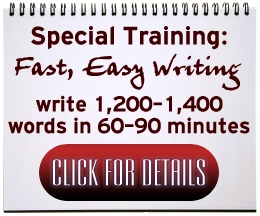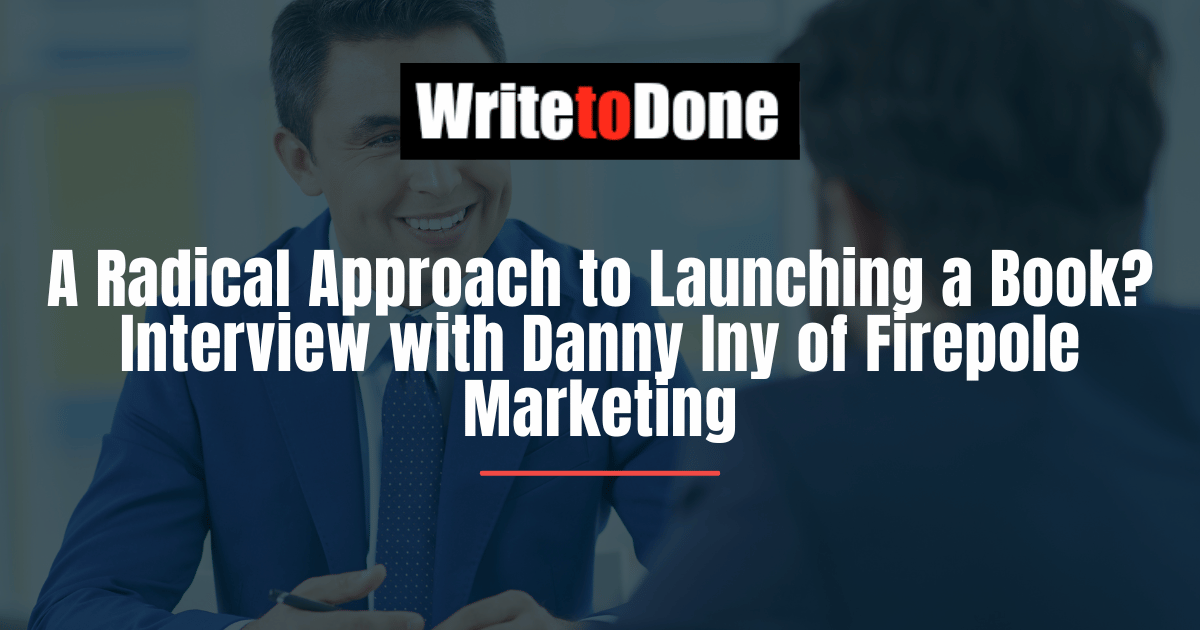Do you plan to write a book at some point in the future?
Writing a book is a big challenge. But there is another hurdle at the end: you have to launch your book. Danny Iny of Firepole Marketing came up with a radical strategy of creating and launching a book when he created Engagement from Scratch. Read about his new strategy in this no-holds-barred interview with Mary Jaksch:
Q: How did you come up with the idea for the book, “Engagement from Scratch”?
A: It started with my own experience building Firepole Marketing, which I started really working on about a year ago, in January 2011.I read and studied everything that I could, and everything that I found about building and growing an audience seemed to assume that you’ve already got one; if you were starting from scratch, there really wasn’t a place for you to go and be pointed in the right direction.
Further down the line, as Firepole Marketing was starting to get some real traction, I wanted to create that sort of “jumping off point” for people who are getting started, but I noticed something interesting – there were a lot of successful people doing what I was doing, and we were all getting good results, so clearly our way worked – but then there were lots of other successful people who were doing different things, and also getting results, so clearly their way worked, too.
I realized that this isn’t a “one path up the mountain” sort of endeavor, and the only way that I could do it justice would be with input from a wide array of audience-builders, which is what I ended up doing with the book.
Q: The book is a great collection of individual articles. What’s your experience of putting together a multi-author book? Do you have tips or warnings?
A: Putting the book together was an amazing experience – I was really blown away by how helpful and considerate the contributors were, and by how much I learned from the the contributions that they sent me. At the same time, I learned that it’s a lot more work than it looks.
For this sort of book to be really good, each contribution has to be “meaty”, which means that you’re going to have to push back with the contributors asking for more content and more information. It also takes a lot of editorial and organization work to make it really flow, and that’s something that I hadn’t really accounted for in my initial timelines and projections.
Q: You’ve come up with a great mind map of how to create a book. Your first step includes writing a great book – and building relationships. Why is it important to build relationships?
A: Well, I should clarify that I came up with the content, strategies and ideas, but the actual map was designed by my friend Matt Tanguay at Fluent Brain. But yeah, the first step is to write a great book, and building relationships. The relationships are important because they drive everything else; for one, without relationships, this book would never have happened, because nobody would have agreed to contribute.
I didn’t build relationships with the intention of asking for something in return, but I did invest a lot in building relationships, right from the start (for example, with Guy Kawasaki – and having him on-board made a huge difference!). Even if I was writing a book on my own, I wouldn’t have gotten anywhere near the exposure, or resulting traction, if I didn’t have great people backing me every step of the way.
Q: Your second step is ‘Learn from others”. I’m especially interested in your strategy of research engineering other book projects. Can you please say more about how you went about that?
A: There’s a story about a disciple who goes to a Zen master and asks him to write down some advice for success in life. The Zen master takes a piece of paper, and writes the word “Attention”. The disciple says that he was hoping for a little more, so the Zen master takes the page, and expands the text to read “Attention! Attention! Attention!”
There’s a lot of wisdom in that, particularly in this day and age when so much happens in public; the first and most important step is to just pay attention to what people are doing, what you’re finding impressive or persuasive and why, and what results they’re seeing. The rest is reverse engineering, but honestly, that’s the easy part – the hardest part is to just pay attention in the first place.
Q: What was the one most critical thing you learned from others?
A: That there is no single insight or trick or strategy to success; rather, building something real is about learning, absorbing, integrating and synthesizing a lot of different insights.
Jim Collins explains this very well with the metaphor of a flywheel; you push the wheel and push the wheel, and each push adds a bit of momentum, until it’s spinning quickly and powerfully. You can’t point to a single push, though, that made the difference. It all comes down to committing yourself to buckle down and do an enormous amount of work – that’s the only way to really get substantial results in the big picture.
Q: Your third step is choosing your launch plan. What worked and what flopped in your launch?
A: It’s hard to answer that question with certainty, because it’s hard to say that results came from this tactic and not that one – they all kind of blend together. I can definitely point to some things that feel more successful and less successful (i.e. I fumbled them), though.
On the more successful side, I think having close to 30 guest posts on major blogs around the launch made a huge difference in terms of the initial spike of traction, and giving the book away for free was of course a cornerstone as well. I also had a very structured follow-up sequence in place that solicited feedback, shares, and reviews from people who had read the book, and I think that worked pretty well, too.<
In terms of stuff that I goofed, the top of the list would be my video trailers (I copied Tim Ferriss’s tactics instead of reverse engineering the strategy), and my Nominate Your Engagement Superstar contest (I live in Canada, and goofed by scheduling the contest for American Thanksgiving weekend). Oh well, live and learn. 😉
Q: Step number four is to give yourself a lot more time than you think. The mind map mentions the Gantt chart in order to organize a project. What tips can you share?
A: The thing is that well experience a sort of Doppler effect with regards to our projections for how long things will take, the further into the future we’re expecting to do them.
There are lots of things that we have to take care of day in and day out, that don’t really get scheduled far in advance; there’s this doctor’s appointment, that meeting with the accountant, these phone meetings, that client engagement, and so forth. They add up to a big chunk of your week, and if I ask you how much time you have to work on a project next week, you’ll be able to tell me fairly accurately, because you know more or less what’s coming.
Looking a few months out, though, we don’t think of these things, and expect to get a lot more done than is probably realistic. We also don’t realize how many different things we may be planning to do in a given month, so creating a Gantt chart helps to visualize the timeline and see where there might be bottlenecks that could trip us up along the way.
Q: What about the actual launch week? What are your suggestions or warnings?
A: Heh, all I can say is that if you’ve done a good job of laying the groundwork, it’s going to be intense. Clear your schedule, don’t plan anything for that week that you don’t have to, and expect to spend your days answering commenters, fixing problems, and hitting refresh to see your stats go up. 😉
Q: You offer the digital version of the book for free. What’s the rationale behind this strategy?
A: They are low ticket items with terrible margins, so unless you’re in a position to sell tens of thousands of them, there isn’t a real financial up-side to selling a book. And realistically speaking, unless you have a significant platform already, you can’t count on sales figures like that.
At the same time, the relationship with the reader (and their opting in to an email list) is more valuable than the few dollars I’d get on a book sale, especially since I can probably get 15-20 people to download it for free for every one person that I could get to buy the book (selling a few hundred or even thousand copies is nice, but not that valuable ultimately, whereas having 5,000-10,000 people download it and subscribe to my list is worth a lot more to me).
Ultimately, my goal for this book is more to grow my audience than to sell lots of copies (though I think people who download it and like it are more likely to buy a copy – who wants to read 240 pages in a PDF?). That being said, if it were just an e-book, it wouldn’t be perceived as being as valuable. Also, the physical book just feels different, and I think that makes a difference for contributors, and for reviewers.
That’s my thinking behind it – I’m pretty sure that it will turn out to be either smart strategic thinking, or a gross error in judgment – one or the other. 😉 The bottom line is that the business model of traditional book publishing is fundamentally broken, and this is just one example of authors getting creative about publishing.
Q: What was the most important thing you learned from creating and launching ‘Engagement from Scratch”?
 A: Any big project is a marathon, not a sprint. Things will get difficult at times, and that’s okay. You’ll stumble and fall from time to time, and that’s okay, too – you just pick yourself up and keep on going. It’s the cumulative energy and momentum that you invest in the project that will ultimately determine its legacy.
A: Any big project is a marathon, not a sprint. Things will get difficult at times, and that’s okay. You’ll stumble and fall from time to time, and that’s okay, too – you just pick yourself up and keep on going. It’s the cumulative energy and momentum that you invest in the project that will ultimately determine its legacy.
Q: What are three main things that writers can learn from reading “Engagement from Scratch”?
A: If I had to boil the book down to three main takeaways that could each fit on a fortune cookie, I’d say that they are (1) Know your audience, (2) Create epic stuff, and (3) Get to work. 🙂
Danny Iny is a co-founder of Firepole Marketing. You can read more great stuff by him on the Firepole Marketing blog. Click here to download the free version of Engagement from Scratch.
















